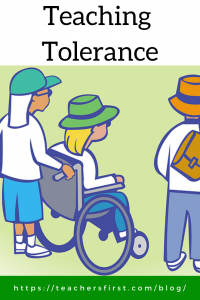 On July 26, 1990, George Bush signed the Americans with Disabilities Act (ADA) into law. This act is the first civil rights act passed that specifically addresses the needs of those with disabilities and prohibits discrimination against disabled people in employment, public services, public accommodations, and telecommunications.
On July 26, 1990, George Bush signed the Americans with Disabilities Act (ADA) into law. This act is the first civil rights act passed that specifically addresses the needs of those with disabilities and prohibits discrimination against disabled people in employment, public services, public accommodations, and telecommunications.
Several years later, in 1975, Gerald Ford signed the Education for All Handicapped Children Act (IDEA) providing guidelines for the commitment to ensuring that children with disabilities have opportunities to develop their talents within the general education classroom through necessary accommodations.
These two acts provide a legal starting point for schools and society, in general, to provide accommodations for anyone with special needs. However, this is just the bare minimum. The more difficult task is to create a culture of inclusiveness and appreciation for all students, without prejudice regarding individual differences.
This article by Brianna Flavin shares nine suggestions for creating an inclusive classroom focusing on some subtle changes and strategies to demonstrate and model diversity in any class. Among the many excellent tips, she suggests using the resources found at Teaching Tolerance (TeachersFirst review).
Teaching Tolerance is a project of the Southern Poverty Law Center and provides tools for educators to reduce prejudice of all kinds. Resources include lesson plans, student texts, student tasks, teaching strategies, printable posters, and more. A quick keyword search of the site using the term disability results in 12 learning plans, 39 lessons, 20 student texts, and additional materials. Filter the results even further to find information by grade level or social justice standards and domains.
There are way too many ideas on Teaching Tolerance to share all of them here, but let’s take a look at some materials from each grade level and how to extend each of the activities to build student awareness for those with disabilities:
- Grades K-2: Taking Action for Accessibility – this lesson goes beyond learning about disabilities and empowers students to generate ideas and plan for how to address differences in their everyday life.
- How to extend this lesson: Encourage students to share their ideas and projects through digital storytelling. WriteReader (TeachersFirst review) is created for very young students and includes features that make it very easy to use. Use the safe image search to add pictures in student stories, and encourage student writers by allowing them to write their text while sharing the “adult” translation on the bottom of the page.
- Grades 3-5: Soccer Teams and Coaches – this is an article that appeared in a newsletter published by The Advocacy Center, an organization supporting families and people with disabilities. The article shares the story of Matt, who is 13 years old with Downs Syndrome and his inclusion by his peers into his soccer team.
- How to use this article and extend learning: Create an account on Teaching Tolerance to save this article to include with a learning plan. Include additional materials about students with disabilities, Newsela (TeachersFirst review) is an excellent starting point to find articles and text sets. Ask students to share their ideas on inclusiveness and helping people with disabilities on Flipgrid (TeachersFirst review).
- Grades 6-8: See the Ability, not the Disability Learning Plan – this learning plan begins with the essential question of why it is important to judge people by their character, not their disability. Included in this complete unit is a series of texts, multimedia, teaching strategies, and student tasks.
- Extend this learning plan: The student task in the learning plan asks students to investigate, interview, and profile someone working for equity and social change. Have students share their findings by creating a webpage using Google Sites (TeachersFirst review). Include recordings or videos of student-led interviews, links to projects and information on the person profiled, and links to sites with additional information on their topic.
- Grades 9-12: Four Perspectives teaching strategy – this strategy details how to teach using the four anti-bias domains within activities where students speak and interact together. The goal of this strategy is to develop speaking and listening skills.
- Take the four perspectives a step further: Ask students to create animated videos using Moovly (TeachersFirst review) to share the information from each of the four different perspectives. Continue your lesson throughout the year by asking students to produce podcasts discussing the latest current events through each of the four viewpoints. Anchor (TeachersFirst review) is an excellent tool for both beginning and experienced podcasters.
Teaching students tolerance for individual differences is not a one-time lesson. Take time to build it into the everyday fabric of your classroom. Using the ideas found on Teaching Tolerance and similar sites provides a starting point for learning activities and serves as a reminder to include an appreciation of individual differences at all times.
Do you have a favorite website, lesson, or activity for teaching about disabilities? Perhaps you have already tried some of the resources found on Teaching Tolerance. If so, we would love to hear your thoughts in the comments.

